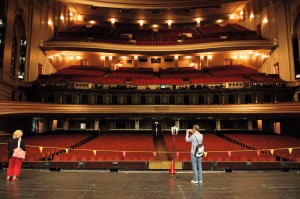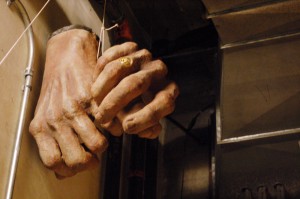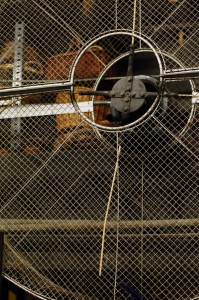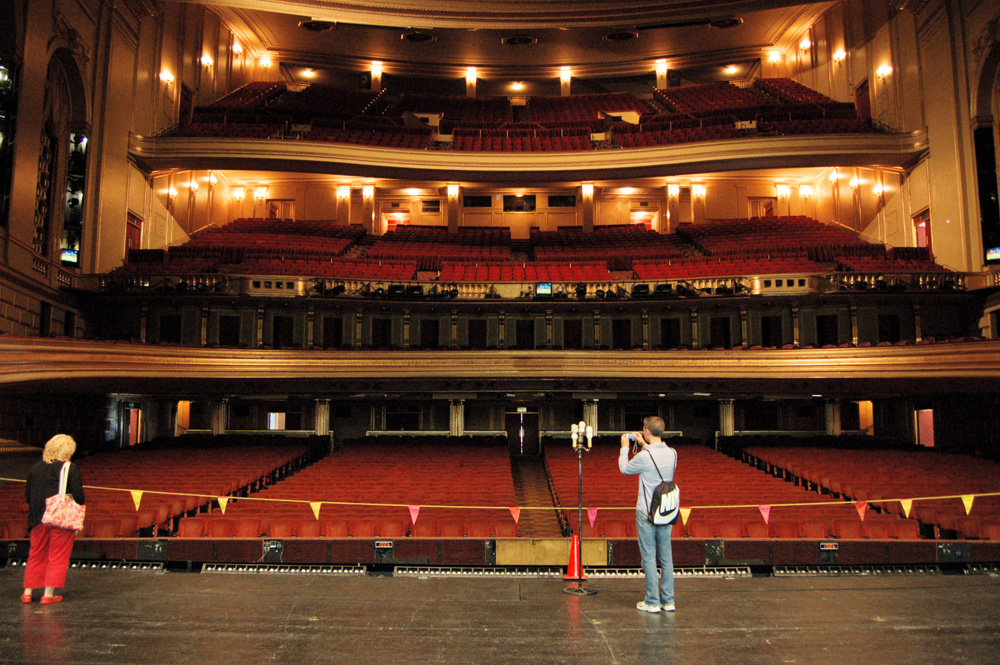Barrington Stage has this short little video talking about where they found some of the props for Freud’s Last Session and what goes into the transfer of a show from one theatre to another.
San Francisco Opera
First of all, tomorrow is Propmaster Day, so mark your calendar. At last year’s S*P*A*M conference, the office of the Mayor of Louisville presented the attendees with a plaque proclaiming July 24th to be Propmaster Day. I say we celebrate it every year. More importantly, that we keep Propmaster Day in our hearts all year ’round.
As part of this year’s conference, we were given a tour of the San Francisco Opera by Lori Harrison, their master of properties. First of all, the stage is huge.

They do their entire season in repertory, sometimes having two changeovers a day when a matinée and evening show are different. Ms. Harrison told us they have about sixteen people in the properties department during the season. Even though more and more operas are being brought in from other shops and opera houses, they still have a lot of work in the props department. Frequently, shops do not understand the rigors and particulars of opera, and furniture pieces need to be rebuilt. Even when props have been built for other operas, the San Francisco Opera has its own unique characteristics that may require rebuilding or adaptation to make the props fit through all the openings and passageways in the path from storage to stage. Finally, as many of us know, a bulk of the props in a show spring forth from the rehearsal process. Even an opera that was “set in stone” at another opera house will have additions and changes to the props before it is performed at the San Francisco Opera.

You have to hand it to the San Francisco Opera; they have a lot of work to do and not a lot of room to do it in. Props are stored throughout the catwalks and on shelves tucked in every little nook and cranny. There is also a small hand props room for common and reusable items on another floor; in addition, they have a warehouse off-site to store larger furniture pieces.

In one of these hidden corners, we came across one of the Opera’s original wind machines dating back to 1932. The fan was about six feet (1.8m) in diameter, and in place of blades were lengths of rubber tubing. They also stored an old-fashioned thunder machine, but it was inside a box and hanging from the ceiling.
Perhaps most striking was the props shop itself; it was much smaller than the props shop at the Public Theatre, and they probably build a lot more large props from scratch, and employ a lot more artisans than us. It just goes to show that there’s always a more efficient way to use the space you’re given.
I found a great article on the making of an opera from 1999 in the San Francisco Weekly. If you read through to the second page, it starts talking about props, and Lori Harrison has a lot of great insights into the process. She says one thing in particular though that I really want to point out:
As the first woman to run the San Francisco Opera prop shop, Harrison, who’s now in her second season in that position, says that it took awhile for some people to get used to the idea of having her in charge. “And some are still getting used to it,” she admits. But while she was prepared for a certain amount of prejudice, there was one particular issue when she first started that caught her off guard. “The question asked was would I rather be called a ‘prop master’ or a ‘prop mistress,'” she says.
“I think ‘master’ works a little better. It expresses mastery over something.”
Hear, hear. To all the prop masters of the world, male or female, have a Happy Propmasters Day tomorrow.
Midweek Link Roundup
Still recovering from my trip out west. Enjoy other people’s webpages for the day:
- What do stylists keep in their kits? Glue, Spit and a Prayer.
- That last link comes from the Propville directory. If you live in the San Francisco Bay Area and work in props, you should check it out. If you don’t, it still has some great articles to read like the one above.
- Need a homeless person sign for your show? Michael Zinman has been collecting them since 2001, and this slideshow has plenty of authentic examples for research purposes.
- Does anyone else watch Cougar Town just for the set design? I don’t, but you might.
Prop Masters Conference Roundup
This past weekend, I visited the lovely city of San Francisco for the first time. It was the 2010 S*P*A*M conference. For those of you not in the know, the Society of Properties Artisan Managers represents full-time properties directors (and their assistants, like me) in theatre, opera, and education. The currently 98 members work in nearly every part of the country and many of the major cities, as well as one in Canada.
As part of the conference, we toured the facilities at the San Francisco Opera and at Berkeley Rep. Each if those may become a blog post in the upcoming days. We also toured Pixar Studios, but that was all secret and no cameras were allowed.
We also had a hazardous communications training seminar with Monona Rossol. It has reminded me that I’ve posted very little information and links about safety on this site.
Finally, S*P*A*M is working on some exciting new things, which I will keep you all apprised of as they happen. I’d write more, but I’m at the airport waiting for my overnight flight home to NYC, and I have to go straight back to work in the morning. This Hart won’t be left in San Francisco!
Importance of Photographing your Work
If you excel at something, it can be hard to describe in words how you differ from someone who is merely competant at it.
A photograph of a finely-made table in your portfolio has a much larger, and much more immediate impact in a job interview than listing the word “carpentry” on your resume.
It can be difficult and sometimes impossible to get photographs from a show you’ve done. Even when you specifically ask someone to take pictures for you, it may take weeks or even months to track them down and get copies of the pictures. The only way to guarantee photographs of your work is to take the pictures yourself; consider the photographs you get from other people to be a bonus surprise.
What goes for production shots goes even more so for process shots. Taking pictures of your prop through it’s various stages of construction are a great way to show an interviewer how you work and how you think. It also gives tangible proof that you know what you’re doing (and eases the mind of those suspicious that you did not do the work yourself). Interviewers love to ask how you achieved something, and having a visual road map of the process in your portfolio can be easier than attempting to describe vague concepts through words alone. Sometimes, you may even teach a new trick or technique to an interviewer, and props people love learning new tricks.
The important thing to remember is that no one will be taking these production photographs for you. You need to make it a habit to take pictures whenever you get to a new stage of your prop’s construction. It will certainly behoove you to learn how to take photographs of your work. It is especially true at the beginning of your career, when you have less of a network and bank of experience to point to your abilities, and the pictures in your portfolio are the sum total of what you have to show for your skills. Sometimes, it can come down to a single interesting and well-documented prop in your portfolio to convince the job interviewer to take a chance on you. That’s certainly happened to me; even when the season has come to a close, the prop master will remember that one prop I had in my portfolio that impressed him.

